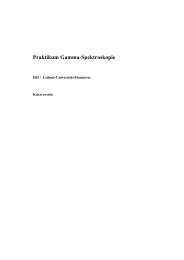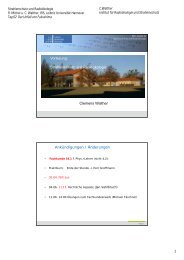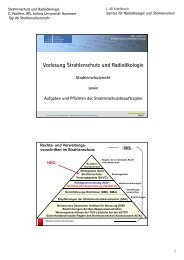Erfolgreiche ePaper selbst erstellen
Machen Sie aus Ihren PDF Publikationen ein blätterbares Flipbook mit unserer einzigartigen Google optimierten e-Paper Software.
262 GLOSSAR<br />
MALDI Matrix assisted laser desorption ionization. MALDI is used for the investigation of delicate<br />
substances (e.g. large biomolecules) by ’soft ionization’. The substance is embedded into<br />
an organic matrix. The laser desorbes material from the surface and during the vaporization<br />
process the molecules are ionized. Subsequently the ions are mass-analyzed in a mass<br />
spectrometer. (Eq. (1.0)) [p. 13]<br />
MASER Device that produces and amplifies electromagnetic radiation mainly in the microwave<br />
region of the spectrum. The name is an acronym derived from ’microwave (or molecular)<br />
amplification by stimulated emission of radiation’. The first maser used a beam of ammonia<br />
molecules that passed along the axis of a cylindrical cage of metal rods, with alternate<br />
rods having positive and negative electric charge. The nonuniform electric field from the<br />
rods sorted out the excited from the unexcited molecules, focusing the excited molecules<br />
through a small hole into the resonator. The output was less than one microwatt (10 −6 W)<br />
of power. (Eq. (1.0)) [p. 5]<br />
MPI cross-section Cross-section for multiphoton ionisation. Symbol µm. The product of MPI-crosssection<br />
times the m-th power of the → power density I m gives the ionisation rate (per<br />
unit time). Therefore the unit of the MPI cross-section is length 2m power −m time −1 (e.g.<br />
µm 2m W −m s −1 ). (Eq. (7.12)) [p. 201]<br />
Offener Resonator Open resonator. Resonator with reflecting surfaces only at both ends along beam<br />
propagation and not along the sides parallel to the beam. (Eq. (2.56)) [p. 30]<br />
Optische Dichte Optical density. Product of optical thickness and molar absorption coefficient<br />
kM (Eq. (8.25)) [p. 217]<br />
Optische Dicke Optical thickness. Product of (molar) concentration and absorption<br />
length (Eq. (8.25)) [p. 217]<br />
Optisches Pumpen optical pumping. The use of light energy to raise the atoms of a system from one<br />
energy level to another. A system may consist of atoms having random individual magnetic<br />
spin quantum numbers. When optically pumped, the atoms will undergo a realignment of<br />
individual magnetic spins with respect to the direction of the light beam; that is, there will<br />
be a rearrangement of magnetic energy levels. (Eq. (1.0)) [p. 6]<br />
Parität Parity A wavefunction that changes its sign by inversion of the space coordinates has odd<br />
(negative) parity. A wavefunction which is symmetric with respect to the origin does not<br />
change its sign under space inversion and has even (positive) parity. (Eq. (4.18)) [p. 98]<br />
PCS(1) Photon correlation spectroscopy. PCS is used for the determination of particle size (i.e.<br />
hydrodynamic diameter) of particles in suspension. Particles move into the beam of a cw<br />
laser due to their Brownian motion and scatter light which is detected by a photon counter.<br />
The larger the particle is, the more slowly is its diffusion and hence the longer it stays in<br />
the laser beam and scatters photons. The time one particle scatters photons is obtained by<br />
calculating the so called self-correlation function of the photon-counter current. From this<br />
function the particle size is obtained. (Eq. (1.0)) [p. 13]<br />
PCS(2) By PCS, the zeta potential (particle charge) can be measured. An electric field is applied<br />
and particles experience a force which is proportional to their charge. Superimposed on













